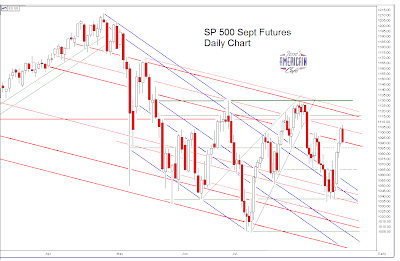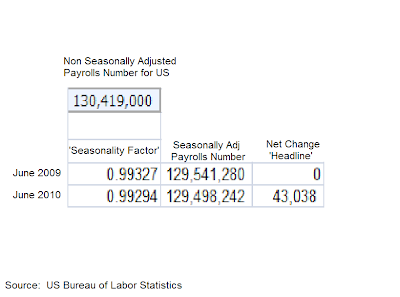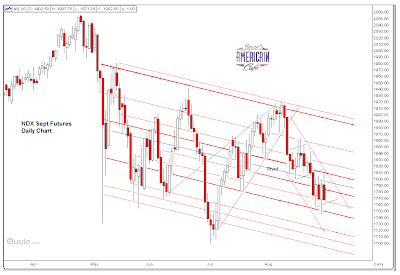"The consequences of this policy are also stark and simple: in effect, China is taxing imports while subsidizing exports, feeding a huge trade surplus. You may see claims that China’s trade surplus has nothing to do with its currency policy; if so, that would be a first in world economic history. An undervalued currency always promotes trade surpluses, and China is no different." Paul Krugman
And he is exactly right. As regular readers know this matter of Chinese mercantilism and its toleration and acceptance by the West has been a key observation and objection here since 2000. Any economist who does not understand that devaluing and then maintaining an artificially low currency peg with a trading partner distorts the nature of that trade should review their knowledge of algebra.
Sophisticated oligarchs do not need to send real tanks against their people. They can accomplish the same objectives using fraud, debt, and corruption. Control the supply of money and care not who makes the laws. But it helps to have the lawmakers and regulators on the payroll.
It was in 1994 during the Clinton Administration that China was permitted to obtain full trading partner "Most Favored Nation" status, while vaguely promising to float their recently devalued currency some day, and address the human rights issues that were endogenous to their non-democratic, totalitarian government.
"From 1981 to 1993 there were six major devaluations in China. Their amounts ranged from 9.6 percent to 44.9 percent, and the official exchange rate went from 2.8 yuan per U.S. dollar to 5.32 yuan per U.S. dollar. On January 1, 1994, China unified the two-tier exchange rates by devaluing the official rate to the prevailing swap rate of 8.7 yuan per U.S. dollar." Sonia Wong, China's Export Growth
This served Mr. Clinton's constituents in Bentonville quite well, and has some interesting implications for the Chinese campaign contributions scandals. It supported the Rubin doctrine of a 'strong dollar' while facilitating the financialization of the US economy and the continuing decline of the middle class wage earners, under pressure to surrender a standard of living achieved at great cost. "How I Learned to Stop Worrying and Love the Currency Collapse." and China's Mercantilism: Selling Them the Rope
Not to limit this, George W. ratified the arrangement when he took office, and so it has gone on for almost fifteen years now, with China 'taxing imports while subsidizing exports' to the disadvantage of its western trading partners.
I expect certain economists who are serving their Chinese clients to make their case to muddy the waters, since this is what they are paid to do. But the silence of the many in this matter was so striking as to be incredible, almost mind boggling. But given the acquiescence of the many in the face of equally absurd theories such as the impossibility of a national housing bubble or pervasive market fraud in naturally efficient markets, we should not be surprised.
Even now someone as knowledgeable as Mr. Krugman can distinguish the inappropriateness of the Chinese unfair trade practice "in current environment" through currency manipulation with prior periods, as if it was all right back then, but somehow is no longer acceptable because of the current economic slump. How can one argue with a straight face that a currency peg that continues for years is not inherently unfair, and a contributing factor to economic imbalances, given the assumption that it imposes a de facto subsidy for exports and penalty for imports?
This is not a trivial distinction but tied to a generational assault on the US middle class. Class Warfare and the Decline of the West.
Perhaps it is a good time to reconsider the principle of the 'neutrality of money' with respect to exchange rates controls and global trade in a purely fiat reserve currency regime as was done with the 'efficient markets hypothesis.' Currency Manipulation and World Trade: A Caution. China is certainly standing western capitalism on its ear and giving it a spin. But this is not without historical precedent, and was predicted by V.I. Lenin himself. I would enjoy this spectacle perhaps if I were observing it from a distance in time.
In a global trade environment tied to external standards such as gold or silver, such egregious imbalances could not grow so large because the metals would impose a certain market discipline requiring a reconciliation and adjustment before monetary excesses became a potentially systemic catastrophe as pointed out so skillfully by Hugo Salinas-Price in Gold Standard: Protector and Generator of Jobs.
The policy errors of the Greenspan and Bernanke Fed, and the outrageously unrealistic if not romantic and utopian theories promulgated by economists about self-correcting markets make me, to borrow a phrase, want to 'bang my head against a wall.'
NYT
China, Japan, America
By Paul Krugman
September 12, 2010
Last week Japan’s minister of finance declared that he and his colleagues wanted a discussion with China about the latter’s purchases of Japanese bonds, to “examine its intention” — diplomat-speak for “Stop it right now.” The news made me want to bang my head against the wall in frustration.
You see, senior American policy figures have repeatedly balked at doing anything about Chinese currency manipulation, at least in part out of fear that the Chinese would stop buying our bonds. Yet in the current environment, Chinese purchases of our bonds don’t help us — they hurt us. The Japanese understand that. Why don’t we?
Some background: If discussion of Chinese currency policy seems confusing, it’s only because many people don’t want to face up to the stark, simple reality — namely, that China is deliberately keeping its currency artificially weak.
The consequences of this policy are also stark and simple: in effect, China is taxing imports while subsidizing exports, feeding a huge trade surplus. You may see claims that China’s trade surplus has nothing to do with its currency policy; if so, that would be a first in world economic history. An undervalued currency always promotes trade surpluses, and China is no different.
And in a depressed world economy, any country running an artificial trade surplus is depriving other nations of much-needed sales and jobs. Again, anyone who asserts otherwise is claiming that China is somehow exempt from the economic logic that has always applied to everyone else.
So what should we be doing? U.S. officials have tried to reason with their Chinese counterparts, arguing that a stronger currency would be in China’s own interest. They’re right about that: an undervalued currency promotes inflation, erodes the real wages of Chinese workers and squanders Chinese resources. But while currency manipulation is bad for China as a whole, it’s good for politically influential Chinese companies — many of them state-owned. And so the currency manipulation goes on.
Time and again, U.S. officials have announced progress on the currency issue; each time, it turns out that they’ve been had. Back in June, Timothy Geithner, the Treasury secretary, praised China’s announcement that it would move to a more flexible exchange rate. Since then, the renminbi has risen a grand total of 1, that’s right, 1 percent against the dollar — with much of the rise taking place in just the past few days, ahead of planned Congressional hearings on the currency issue. And since the dollar has fallen against other major currencies, China’s artificial cost advantage has actually increased.
Clearly, nothing will happen until or unless the United States shows that it’s willing to do what it normally does when another country subsidizes its exports: impose a temporary tariff that offsets the subsidy. So why has such action never been on the table?
One answer, as I’ve already suggested, is fear of what would happen if the Chinese stopped buying American bonds. But this fear is completely misplaced: in a world awash with excess savings, we don’t need China’s money — especially because the Federal Reserve could and should buy up any bonds the Chinese sell.
It’s true that the dollar would fall if China decided to dump some American holdings. But this would actually help the U.S. economy, making our exports more competitive. Ask the Japanese, who want China to stop buying their bonds because those purchases are driving up the yen. (Cui bono, Mr. Krugman, cui bono? - Jesse)
Aside from unjustified financial fears, there’s a more sinister cause of U.S. passivity: business fear of Chinese retaliation.
Consider a related issue: the clearly illegal subsidies China provides to its clean-energy industry. These subsidies should have led to a formal complaint from American businesses; in fact, the only organization willing to file a complaint was the steelworkers union. Why? As The Times reported, “multinational companies and trade associations in the clean energy business, as in many other industries, have been wary of filing trade cases, fearing Chinese officials’ reputation for retaliating against joint ventures in their country and potentially denying market access to any company that takes sides against China.”
Similar intimidation has surely helped discourage action on the currency front. So this is a good time to remember that what’s good for multinational companies is often bad for America, especially its workers.
So here’s the question: Will U.S. policy makers let themselves be spooked by financial phantoms and bullied by business intimidation? Will they continue to do nothing in the face of policies that benefit Chinese special interests at the expense of both Chinese and American workers? Or will they finally, finally act? Stay tuned














































































